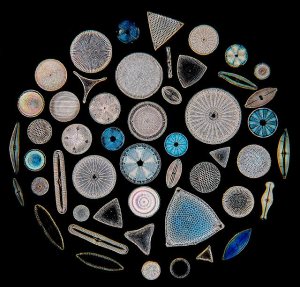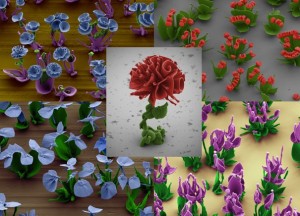Beautiful flowers in small packages
Anyone who has seen my home knows that I have a bit of a… hmm… obsession with orchids. To control my orchid intake, I meter my purchases to buying more plants only after I have either mastered or killed my latest orchid purchase. This has resulted in nearly 20 pots of these gorgeous plants with orchid “spa treatment days” (i.e., deep watering days) lasting hours at a time. So you can probably imagine the enthusiasm with which I embraced a recent article from the journal Science, in which Harvard researchers Wim L Noorduin and colleagues proclaim that they have discovered how to create predictable complex nano- and microstructures via biomineralization techniques, and then demonstrate this by creating micro-flowers!
Self-assembly of complex forms occur regularly in nature as a result of dynamic interactions with the surrounding environment. Many of these structures have a stunning beauty to them, with snowflakes being one of the most well-known examples of this phenomenon. The claim that no two snowflakes are alike is based on the understanding that the basic shape of a snowflake is guided by a combination of atmospheric temperature and humidity. However, its individuality is “crafted” as it falls through the atmosphere, tracing unique paths and being exposed to different air patterns as its shape shifts with each tumble, spin, pitch and glide, and twirl.
Another, perhaps lesser-known example is the shells of diatoms, a type of algae that is characterized as being encased in a shell formed of silica. These silica shells often exhibit a remarkable level of complexity, being extremely porous to permit gas and nutrient exchange with the surrounding environment.
What makes them of particular interest to physicists and materials scientists is their ability to repeatedly produce these intricate and complex shells through self-assembly with such accuracy that the identification and classification of these creatures can be guided by the patterns and placements of their pores.
Until recently, the study of how these patterns emerge has focused on looking at the chemical compositions and material properties of complex microsystems, or has worked on defining the initial conditions required to generate these forms. While the understanding that complex structures are usually created as a result of dynamic interactions with the surrounding environment is well-accepted, how these complex structures form through self-assembly had never yet reached the point of being something scientists could predict.
So Noorduin and co-authors set off undaunted to discover how dynamic environmental interactions can be used to generate predictable, patterned precipitation in synthetic systems, to create self-assembled complex structures… repeatedly (i.e., in a predictable manner).
It turns out that the secret to growing complex structures is to subject the solution to a dynamically-changing environment, one that responds to its growing shape. The images to the left are scanning electron micrographs that have been artificially colored, but aren’t they beautiful?
It’s important to realize that while Noorduin and colleagues did produce these flowers as a beautiful demonstration of their technique, that all of this isn’t purely just for fun and games. Rather, if we can harness the basic principles guiding self-assembly, especially that of biomineralization, this will change the face of how nano- and micromaterials are made.
As of now, our go-to method for creating nanomaterials is by using lithography techniques, through which 3D structures are laboriously etched. Not only is this slow, it is also very, very expensive. Using the methods this group is developing, it will soon become possible to mass-manufacture complex materials for drug delivery, development of catalysts for chemical production, micro-circuitry, etc., by mechanisms of self-assembly.
The possibilities are truly… endless.
Related articles
- Pictures: Nano “Flowers” Created in Lab (news.nationalgeographic.com)
- Harvard Researches Grow a Garden of Nanoscience Flowers (boston.com)
- Microscopic crystal ‘flowers’ build themselves in a Harvard lab (science.nbcnews.com)



Thanks for finally talking about >Beautiful flowers in small packages | Temple Biomimetics and Bioinspiration
<Liked it!
Thanks!! I’m so glad you enjoyed it.